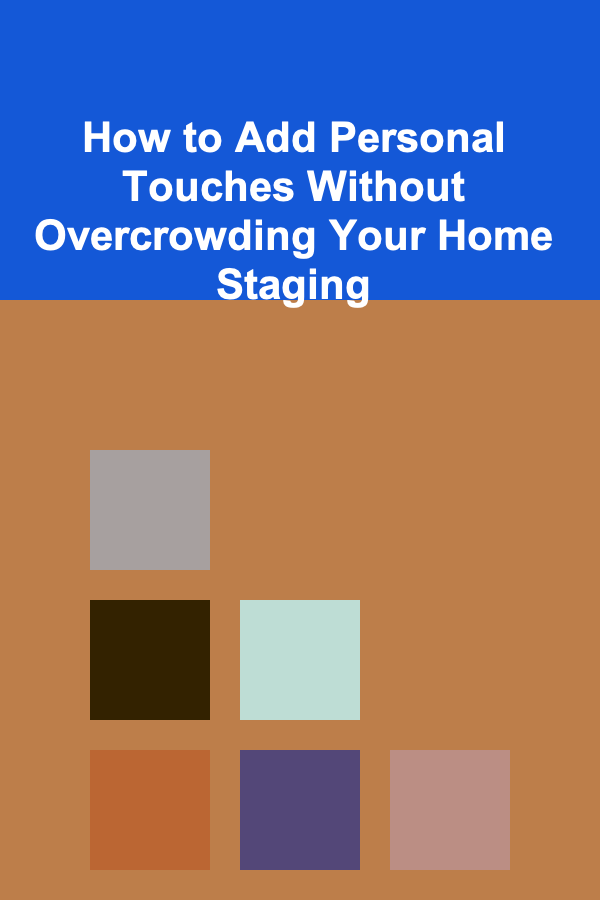
How to Add Personal Touches Without Overcrowding Your Home Staging
ebook include PDF & Audio bundle (Micro Guide)
$12.99$11.99
Limited Time Offer! Order within the next:

Home staging is a crucial step in selling a property, allowing potential buyers to envision themselves in the space. It's all about creating an environment that feels welcoming, stylish, and functional. However, one of the most common challenges homeowners and real estate agents face during staging is how to add personal touches without overcrowding the space. While you want your home to feel lived in and inviting, you also want to avoid overwhelming buyers with too many personal items or too much décor. Striking the perfect balance between style and simplicity is key to effective staging.
In this article, we'll explore how to incorporate personal touches into home staging in a way that enhances the space without detracting from its appeal. We'll discuss practical tips, strategies, and examples of how to give your home character, warmth, and individuality while maintaining an open, spacious, and neutral environment that will attract buyers.
Understanding the Balance Between Personal and Neutral
Home staging is primarily about making the space feel as universally appealing as possible. This means choosing neutral colors, minimalist furniture, and creating an open, clutter-free environment that allows potential buyers to visualize themselves in the home. However, that doesn't mean the space has to feel sterile or impersonal.
The trick is to add personal touches that reflect the home's personality without overtaking it. These touches should feel subtle, tasteful, and complementary to the home's architecture and design. The goal is not to make the space feel like it's "yours" but to create a sense of warmth and livability that invites potential buyers in.
How to Strike the Right Balance
- Start with Neutral Foundations: Begin with a neutral palette of whites, grays, and beiges for the walls, floors, and larger furniture pieces. This will create a blank canvas that allows for the addition of personal touches without feeling crowded.
- Choose a Few Personal Items: Instead of filling every surface with personal mementos, choose a few carefully selected items to create visual interest and a sense of personality.
- Focus on the Feeling, Not the Specifics: Your goal is to convey a feeling of warmth, coziness, and livability through your personal touches, rather than a direct reflection of your personality or lifestyle.
Using Art and Decor Strategically
One of the easiest ways to add personal touches to home staging is through the use of art and décor. Artwork, sculptures, or other decorative items can inject personality into a room, but it's important to choose pieces that align with the neutral, clean aesthetic of the space.
Art that Enhances, Not Overpowers
When selecting art for home staging, consider pieces that are sophisticated and complement the overall tone of the room. Avoid overly personal or controversial artwork (such as family photos or overly specific images) that could make the space feel too "lived in." Instead, choose neutral, abstract, or nature-inspired pieces that appeal to a wide audience. Large pieces of artwork can make a statement, but they should never overshadow the room's layout or functionality.
Tips for Using Art in Home Staging:
- Use Color as a Subtle Accent: Choose artwork that uses a color palette that complements the room's colors. For example, in a living room with neutral walls, a large piece of abstract art with soft pastels or earth tones can add sophistication without clashing with the space.
- Create Balance with Small Accents: A single, large piece of art may be appropriate for a feature wall, but smaller art pieces can also be arranged together to create a cohesive look. Place them in unexpected areas to maintain interest without overwhelming the space.
- Avoid Overcrowding Walls: Be mindful of the amount of wall art you include. Too much can make the space feel busy, distracting from the home's architectural features.
Textiles as Personal Touches
Throw pillows, blankets, and rugs are another way to add personality to a space while maintaining a clean look. Again, the key is balance. When choosing textiles for staging, look for soft, neutral colors or simple patterns that won't overpower the room but will provide texture and comfort.
How to Incorporate Textiles:
- Throw Pillows: A few well-placed throw pillows on a neutral-colored sofa can add warmth and comfort. Stick to calming colors like light grays, soft whites, or muted blues. Avoid busy patterns that could make the space feel chaotic.
- Area Rugs: An area rug can help define a space, such as the living room or dining area. Look for rugs with a simple, elegant design that ties the room together but doesn't take center stage.
- Blankets and Throws: A cozy throw blanket on the edge of a sofa or bed can give the space a lived-in feel without overwhelming the design.
Adding Greenery Without Cluttering the Space
Plants are a wonderful way to introduce life into a room, and they are often used in home staging to make a space feel more vibrant and fresh. However, it's essential not to overdo it. Too many plants or oversized planters can make the space feel crowded or overly cluttered.
Select Plants that Suit the Space
The key is to choose a few plants that are the right size and style for each room. Tall, dramatic plants can be beautiful in larger spaces, while smaller, more compact plants are perfect for cozy corners or tables.
Best Plants for Staging:
- Fiddle Leaf Fig: A popular plant known for its bold, glossy leaves, it works well in larger rooms or spaces with high ceilings. Place it in a corner to add height and drama.
- Snake Plant: A low-maintenance plant that fits well in smaller spaces, it adds a touch of greenery without taking up too much room.
- Succulents: Perfect for countertops or shelves, small succulents are an excellent way to add life to a room without overwhelming it.
- Herbs: For kitchens or dining areas, small potted herbs like basil, rosemary, or thyme can be both functional and aesthetically pleasing.
Pottery and Planters
Just as important as the plants themselves is how they're displayed. Choose simple, neutral pots or planters that complement the room's décor. Avoid overly decorative or brightly colored planters, as they can detract from the space's overall look.
Highlighting Architectural Features with Subtle Accents
If your home has special architectural features, such as exposed brick, wooden beams, or large windows, these are the elements you want to emphasize. Personal touches should never overshadow the room's natural beauty, but rather enhance the features that make the space unique.
How to Accentuate Architecture:
- Open Shelving: If you have shelves that showcase beautiful books, objects, or even plants, leave them open and clutter-free. A few carefully chosen objects, like a vase or a unique sculpture, can highlight the shelves without creating visual chaos.
- Feature Lighting: Use lighting to accentuate key architectural features, such as a beautiful fireplace, an exposed staircase, or artwork. Pendant lights or a statement chandelier can add elegance and bring attention to specific areas of the room.
Creating a Welcoming Atmosphere with Scent and Sound
Although home staging is often focused on visual appeal, scent and sound are just as important. A well-chosen fragrance can add warmth and a sense of comfort to a home, making it feel more inviting to potential buyers. Similarly, the right sound can evoke a peaceful, calming atmosphere.
Scent: Subtle, Inviting Fragrances
Avoid overpowering scents like heavy candles or air fresheners, which can feel artificial. Instead, choose subtle scents like fresh flowers, a hint of vanilla, or a gentle citrus fragrance. Consider using essential oils or lightly scented candles that create a clean, fresh feeling without overwhelming the space.
Sound: Soft, Ambient Music
While this may not be a common staging element, playing soft, ambient music during open houses can create a calming atmosphere. Consider using instrumental music or nature sounds at a low volume to set the tone without distracting from the overall experience of the home.
Decluttering to Make Space for Personal Touches
Ultimately, the key to adding personal touches without overcrowding your home staging is decluttering. A clutter-free environment makes even small personal items stand out and feel more intentional. Removing excess furniture, décor, and personal items allows potential buyers to focus on the space itself.
How to Declutter Effectively:
- Remove Excess Furniture: Only keep essential pieces of furniture that highlight the functionality of the room. If a piece is not necessary for the room's flow, consider removing it.
- Organize Storage Spaces: Buyers will often open closets, cabinets, and drawers. Make sure they are tidy and organized so that the space feels larger and more functional.
- Clear Countertops: In kitchens and bathrooms, clear countertops of all unnecessary items. A few decorative pieces or a plant can add personality, but avoid leaving out too many products or gadgets.
Conclusion
Adding personal touches to your home staging can be a delicate balance. The goal is to create an inviting, warm, and appealing space that allows potential buyers to picture themselves living there. By using art, décor, greenery, and subtle accents, you can infuse your home with personality and charm without overcrowding the space or detracting from its key features.
Remember, home staging is about creating an atmosphere that feels comfortable, open, and neutral while allowing buyers to imagine their own lives in the space. By carefully curating personal touches that enhance the room's beauty, rather than overpowering it, you can create a home that feels uniquely yours while appealing to a broad audience.
Reading More From Our Other Websites
- [Organization Tip 101] How to Organize Kitchen Essentials in a Rental Property
- [Weaving Tip 101] Weaving Your Second Chapter: Creative Techniques for Reinventing Yourself
- [Home Space Saving 101] How to Create a Functional Workspace with a Desk with Built-in Storage
- [Home Maintenance 101] How to Choose the Right Products for Home Maintenance
- [Organization Tip 101] Best Time‑Blocking & Task Management Systems for Peak Personal Organization
- [Organization Tip 101] How to Use Hooks and Racks for Gym Bag Storage
- [Digital Decluttering Tip 101] The Digital Declutter Checklist: Streamline Apps, Notifications, and Storage
- [Soap Making Tip 101] Creative Recipes: Adding Scents and Colors to Shea Butter Soap
- [Home Budget Decorating 101] How to Create a Low-Cost Living Room: Affordable Ideas for a Cozy Space
- [Home Holiday Decoration 101] How to Make Your Own Holiday Gift Wrap

How to Clean Your Home in 30 Minutes a Day
Read More
How to Keep Track of RSVPs and Meal Preferences for Your Wedding
Read More
10 Tips for Teaching Your Cat Tricks: A Fun Training To-Do List
Read More
10 Tips for Nonprofit Event Planning on a Budget
Read More
10 Tips for Maintaining Your Sauna: Longevity and Efficiency
Read More
10 Tips for Eco-Friendly Wrapping Paper Alternatives
Read MoreOther Products

How to Clean Your Home in 30 Minutes a Day
Read More
How to Keep Track of RSVPs and Meal Preferences for Your Wedding
Read More
10 Tips for Teaching Your Cat Tricks: A Fun Training To-Do List
Read More
10 Tips for Nonprofit Event Planning on a Budget
Read More
10 Tips for Maintaining Your Sauna: Longevity and Efficiency
Read More